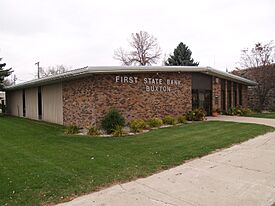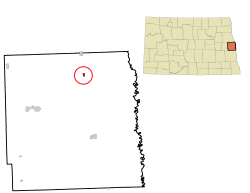Buxton, North Dakota facts for kids
Quick facts for kids
Buxton, North Dakota
|
|
|---|---|

The First State Bank of Buxton
|
|

Location of Buxton, North Dakota
|
|
| Country | United States |
| State | North Dakota |
| County | Traill |
| Founded | 1880 |
| Incorporated (village) | 1922 |
| Incorporated (city) | 1967 |
| Area | |
| • Total | 0.334 sq mi (0.865 km2) |
| • Land | 0.334 sq mi (0.865 km2) |
| • Water | 0.000 sq mi (0.000 km2) |
| Elevation | 932 ft (284 m) |
| Population
(2020)
|
|
| • Total | 348 |
| • Estimate
(2023)
|
349 |
| • Density | 1,041.92/sq mi (402.47/km2) |
| Time zone | UTC–6 (Central (CST)) |
| • Summer (DST) | UTC–5 (CDT) |
| ZIP Code |
58218
|
| Area code(s) | 701 |
| FIPS code | 38-11340 |
| GNIS feature ID | 1035949 |
Buxton is a city in Traill County, North Dakota, United States. The population was 348 at the 2020 census. Buxton was founded in 1880.
Contents
History
Buxton was founded in 1880 in Buxton Township as a townsite along the Great Northern Railroad in 1880. The post office began operating in November of that year. It was incorporated as a village in 1922. It became a city in 1967, after the North Dakota Legislature enacted legislation that eliminated all existing incorporation titles for towns and villages in the state.
The town was named after Thomas J. Buxton, who at the time was the city treasurer in Minneapolis, Minnesota. Buxton was a close friend and business associated of the town's founder, Budd Reeve.
Geography
According to the United States Census Bureau, the city has a total area of 0.334 square miles (0.87 km2), all land.
Demographics
| Historical population | |||
|---|---|---|---|
| Census | Pop. | %± | |
| 1930 | 410 | — | |
| 1940 | 404 | −1.5% | |
| 1950 | 387 | −4.2% | |
| 1960 | 321 | −17.1% | |
| 1970 | 235 | −26.8% | |
| 1980 | 336 | 43.0% | |
| 1990 | 343 | 2.1% | |
| 2000 | 350 | 2.0% | |
| 2010 | 323 | −7.7% | |
| 2020 | 348 | 7.7% | |
| 2023 (est.) | 349 | 8.0% | |
| U.S. Decennial Census 2020 Census |
|||
2020 census
| Race | Number | Percentage |
|---|---|---|
| White (NH) | 329 | 94.5% |
| Black or African American (NH) | 2 | 0.6% |
| Native American or Alaska Native (NH) | 4 | 1.1% |
| Asian (NH) | 0 | 0.0% |
| Pacific Islander (NH) | 0 | 0.0% |
| Some Other Race (NH) | 0 | 0.0% |
| Mixed/Multi-Racial (NH) | 9 | 2.6% |
| Hispanic or Latino | 4 | 1.1% |
| Total | 348 | 100.0% |
As of the 2020 census, there were 348 people, 132 households, and 97 families residing in the city. The population density was 1,735.0 inhabitants per square mile (669.9/km2). There were 143 housing units at an average density of 713.0 per square mile (275.3/km2). The racial makeup of the city was 94.8% White, 0.6% African American, 1.1% Native American, 0.0% Asian, 0.0% Pacific Islander, 0.6% from some other races and 2.9% from two or more races. Hispanic or Latino of any race were 1.1% of the population. 22.0% of residents were under the age of 18, 7.8% were under 5 years of age, and 14.3% were 65 and older.
2010 census
As of the 2010 census, there were 323 people, 136 households, and 91 families residing in the city. The population density was 1,615.0 inhabitants per square mile (623.6/km2). There were 144 housing units at an average density of 720.0 per square mile (278.0/km2). The racial makeup of the city was 99.4% White, 0.3% African American, and 0.3% Native American. Hispanic or Latino of any race were 0.9% of the population.
There were 136 households, of which 30.9% had children under the age of 18 living with them, 59.6% were married couples living together, 2.9% had a female householder with no husband present, 4.4% had a male householder with no wife present, and 33.1% were non-families. 28.7% of all households were made up of individuals, and 13.9% had someone living alone who was 65 years of age or older. The average household size was 2.38 and the average family size was 2.97.
The median age in the city was 39.4 years. 23.2% of residents were under the age of 18; 7.7% were between the ages of 18 and 24; 28.9% were from 25 to 44; 26.7% were from 45 to 64; and 13.6% were 65 years of age or older. The gender makeup of the city was 51.4% male and 48.6% female.
Transportation
Amtrak’s Empire Builder, which operates between Seattle/Portland and Chicago, passes through the town on BNSF tracks, but makes no stop. The nearest station is located in Grand Forks, 25 miles (40 km) to the north.
Education
It is within the Central Valley Public School District 3.
Notable people
- Asle J. Gronna, U.S. Senator (1911–1921)
- Ragnvald Nestos, Governor (1921–1925)
- Kemper Nomland, architect
- Mancur Olson, economist
- Arthur G. Sorlie, Governor (1925–1928)
- Brent Vigen, head football coach at Montana State University (2021– )
See also
 In Spanish: Buxton (Dakota del Norte) para niños
In Spanish: Buxton (Dakota del Norte) para niños

